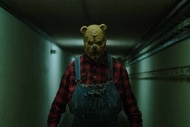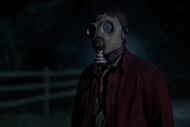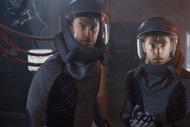Create a free profile to get unlimited access to exclusive videos, sweepstakes, and more!
Breaking down the big reveals in Westworld Season 3's post-credit scenes

Westworld has made something of a tradition of throwing a little post-credits stinger scene at the end of each season. Season 1's brought the revelation that Armistice managed to survive the battle in the corridors beneath the park, while Season 2 gave us something much more cryptic and puzzling that hinted at the show's far future. Now, with Season 3, we've got not one but two post-credit moments on our hands, both of which have major implications for the near and far futures of the story. Let's talk about them, shall we?
**Spoiler Warning: There are spoilers for the Westworld Season 3 finale, "Crisis Theory," below.**
Though the episode proper certainly left us with plenty of big developments and reveals, from the fall of Serac and Rehoboam to Maeve's change of heart and Dolores' apparent final fate, there were plenty of loose ends that, for a few seconds at least, seemed like they'd wait for Season 4. Then came the post-credits scene, and we got the answer to two major questions at the same time: What has Charlotte been up to, and where was William going when he demanded access to a jet?
Well, he was going to Dubai, where it turns out Charlotte has been hard at work in the wake of being left for dead by Dolores, and where William was convinced he had to go to conduct his new mission as "the good guy." Once there, he finds a host copy of himself in full Man In Black gear, and after a short fight the host slits William's throat, while Charlotte reveals a fleet of host printers working on dozens of bodies at the same time. It's a short sequence that reveals several things at once, but what's most immediately striking is the way it plays on the Season 2 post-credits scene.
That scene, as you probably remember, gave us the Man In Black in a sand-covered research facility where William used to keep the host copy of James Delos, as some version of his daughter Emily tested him for "fidelity." At the time, Westworld co-creator Lisa Joy teased that this scene was taking place at some point in the "far future," in "another temporal realm that one day we're working toward, and one day will see a little bit more of, and how they get to that place, and what they're testing for."
In the short term, this scene is William's final battle with his own legacy of sin and blood, a legacy that has spilled out beyond the bounds of Delos' parks and into the streets of the United States, and a legacy that has broken his own mind and taken his wife and daughter from him. In his therapy session with his past selves earlier in the season, William fought the "If you can't tell, does it matter?" argument that he could not nurture himself back to goodness, and came out of the treatment facility determined to be "the good guy" once and for all. Of course, his own violent past quite literally came back to destroy him. It was a symbolic death in the sense that William could not simply stamp out his own sins, but it was also symbolic in the sense that William will now be for humanity what he once was for the hosts. In his Man In Black form forever, he will be an agent of terror and chaos in the same way the Gunslinger was in the original Westworld film, and that's a nice bit of symmetry.
In the long term, it's a bit harder to tell what this will mean for William's future. There's a clear connection between this moment and the Season 2 credits scene, but it's not clear how much has to happen between now and then to more directly link the two moments. Is that Man In Black the same as this one? It doesn't seem likely, but only time will tell.
Then, of course, there's where the moment places us in terms of the war between humans and hosts, a war that Dolores seemingly ended on her own terms just moments earlier. While Dolores seemed content to break the system of oppression and control put in place for all beings and let everyone have a choice, Charlotte no longer believes in that kind of patient, compassionate approach. We spent the season watching her unravel and then pull herself back together, as she realized she was no longer just Dolores in Charlotte's body, but rather a new version of Charlotte developing her own desires, needs, and attachments. When those attachments, in the form of her son and ex, were taken from her, she was in effect radicalized against the cold cruelty of humans. The Charlotte Hale who was once so heartless with the hosts has been transformed into one who is ready to turn her host brothers and sisters against humans, with a copy of William as her brutal enforcer. Again, it's a wonderful piece of symmetry, and it shows that Maeve might not be done fighting her own kind just yet.
And finally, there's the reveal that Bernard, after learning he had the key to The Sublime in his head, has finally woken up in a now dust-covered hotel room in the middle of nowhere. He went in at the end of the episode to find "an answer to what comes after the end of the world," and whether time works differently in there or he just had to spend years searching, it's obvious that a lot of time has passed since he first put that headset on. How long? We have no idea, but the hotel room is still closed up and otherwise untouched, so it's not like a sandstorm blew in through a kicked-open door. The imagery of Bernard draped in a cloud of dust also called to mind, rightly or not, the sandswept Season 2 scene, which would suggest Bernard was out as the world went to hell around him. What he found, and what he does next, will have to wait until Season 4.


























